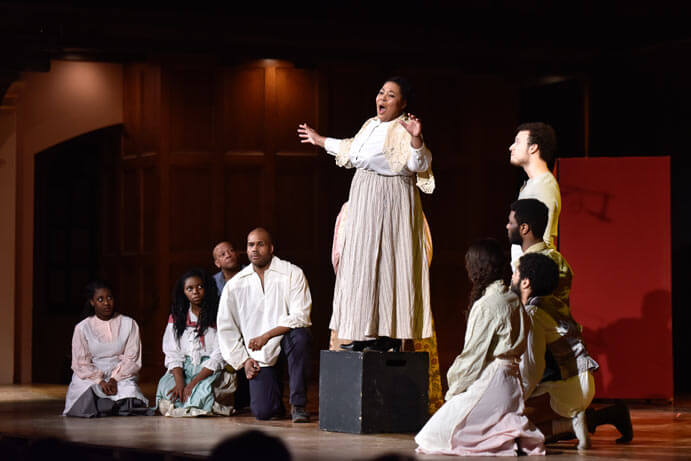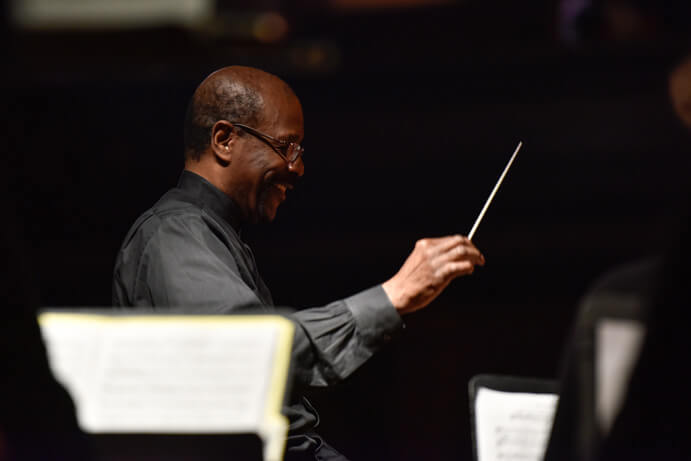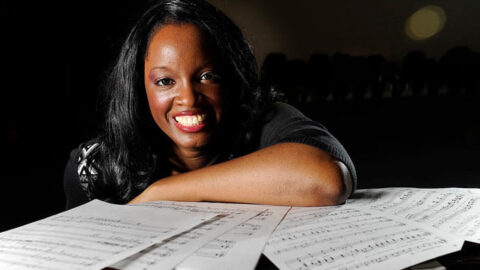In her opera Harriet Tubman: When I Crossed that Line to Freedom, composer-librettist Nkeiru Okoye deftly pieces together a kaleidoscopic musical fabric of disconcerting beauty equalling that of the quilt masterpieces of Gees Bend, Alabama. Even in the condensed version presented in its Midwest premiere run by Cleveland Opera Theater and Oberlin Opera Theater on February 6, 2016 at Oberlin College and Conservatory, the power of Okoye’s creation held sway.
Okoye, a 1992 graduate of Oberlin Conservatory, spent 10 years researching and writing Harriet Tubman. The complete two-hour opera in four acts, conceived for five lead roles with chorus and orchestra, deserves a full-scale production by a major opera company. The reduced one-hour, two-act version was crafted for portability (it was also presented in four area churches). Featuring the five main characters, a five-member chorus, and an ensemble of string quintet and piano, it was conducted with verve and focus by Julius Williams. Stage director Jonathon Field made effective use of period costumes and a minimal set.
This version tells Tubman’s story in a tightened arc from her early abuse as an enslaved child to her flight to freedom as a young woman to becoming “Moses the Liberator” to her people. Okoye’s score threads diverse styles and influences into a coherent whole that never sounds like pastiche. Gospel, minstrel, and blues forms are authentic to her characters and employed in ways that call upon the substantial resources of operatic singers. The writing for Harriet’s arias — “My Name is Harriet Now,” “I Am Harriet Tubman,” and the finale, “I am Moses” — is particularly demanding.

Soprano Amber Monroe reveled in the title role. She handled the varied challenges with equal skill and aplomb, from the sweet innocence of young “Minty” in her opening aria to the fiery defiance of the closing “I am Moses.” Monroe, a third-year vocal performance major at Oberlin Conservatory, is developing a magnificent instrument with powerful richness in her lower register and a bell-clear top. This is a name to remember.
The rest of the leading cast — Victoria Ellington as sister Rachel, Debra Rose as mother Rittia, David Hughey as father Ben (and abolitionist William Still), and Brian Keith Johnson as sometimes husband John Tubman — ably handled both the vocal and acting demands of their roles. The chorus impressively reinforced arias with harmony and carried the intervening action well. The “three brothers” chorus was particularly enjoyable, adding levity and gravity as the scenes demanded. The diction of the entire cast was excellent throughout.
The score has a strong rhythmic drive, carried primarily in this chamber version by the piano and bass. The ensemble — Molly Tucker and Ryan McDonnell, violins; Chris Jenkins, viola; Rebecca Landell Reed, cello; Ivan Aidan, bass; and Elena Loskova, piano — was alert to Williams’ every nuance and kept the action in perpetual motion.

Harriet Tubman is not without its faults. In the condensed version, intermittent narration by a rotation of characters disrupted the musical continuity of Okoye’s taut score. Further, it was less effective in carrying the story along than the connective recitative passages in the full version. Perhaps this is a small enough price to pay for portability. The libretto is written in colloquial middle-American English, which no doubt ensures accessibility for the largest possible audience. But it thus lacks some of the poetic power it would have if written in more historically accurate dialect.
Despite these issues, even the reduced version of Harriet Tubman packs an emotional, historical, and political punch. We officially put slavery behind us in 1865 and have made substantial progress towards racial equality since the civil-rights struggles of the mid-20th century. But the struggle continues. There are more African American adults in prison today than were enslaved in 1850. And even a town and campus with long historical ties to social and racial justice movements is not entirely free of the American legacy of racism and white supremacy. One need only read the recent demands by ABUSUA, an Oberlin Black students organization, for evidence that serious issues still need to be addressed.
The packed house at Finney Chapel was remarkable for its diversity, drawing from all sectors of the community. This a testament to the benefit of celebrating a largely African American production, if indeed your goal is true diversity and inclusion. As Harriet invokes in her stirring, climactic aria, “I Am Harriet Tubman”: “I’ll keep crossing that line to freedom, until we all are free!” That is sound advice to us all.
























